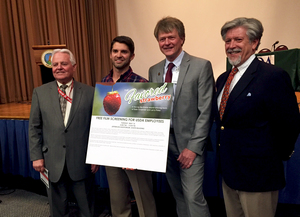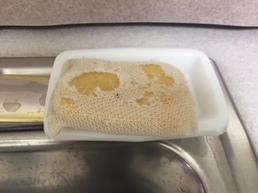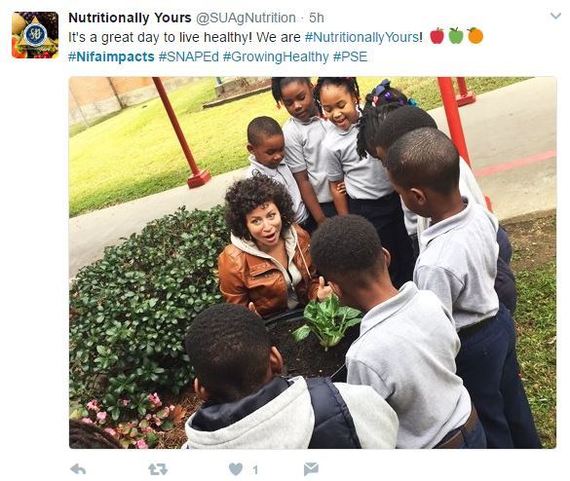|
|
|
Fresh from the Field is a weekly album showcasing transformative impacts made by grantees funded by the National Institute of Food and Agriculture.
May 25, 2017
|
|
Success Stories
 Strawberry fields forever
According to USDA, the United States is the world’s largest producer of
strawberries. From farms to fields, growers are discovering ways to perfect the
quality and taste of the flavorful fruit. "The Favored Strawberry" is a new
documentary that highlights the immigrants, scientists, and extension
specialists whose work affects all aspects of strawberry production. The
film, overseen by the University of Arkansas, is part of the National
Strawberry Sustainability Initiative. The documentary highlights USDA and NIFA investments in strawberry breeding and research. The USDA recently hosted a screening with
special guests Curt Rom of the University of Arkansas, Ben Butler of Butler’s
Orchard in Germantown, Maryland, and John Lea-Cox of the University of Maryland. Lea-Cox appears in the film and discusses his
wireless irrigation system, funded by NIFA’s Specialty
Crop Research Initiative (SCRI).
The
film notes that strawberries are often cultivated with methyl bromide, a
pesticide that has been used for over 50 years for a range of pest management
purposes from farming to storage, to shipment and quarantine. NIFA’s Methyl Bromide Transition (MBT) supports research on new, environmentally
friendly pesticides and innovative tools and strategies to replace the older
methyl bromide treatment option.
The
film also mentions the RosBreed project, managed by Michigan State University and
involving researchers and institutions from all over the U.S. Funded through
NIFA Specialty Crop Research
Initiative (SCRI),
RosBreed develops genomic tools to help breeders identify genes for traits such
as drought tolerance and disease resistance.These tools can shorten the time
required to develop new cultivars by years and save hundreds of thousands of
dollars.
Listen
to USDA's Radio interview with Curt
Rom of the University
of Arkansas.
|
 Making a refuge for crops
For 20 years, growers have used Bt crops to minimize damage from
pests. Bt crops, including corn, are genetically engineered to produce
proteins from the Bacillus thuringiensis (Bt) bacterium. These proteins are
harmless to vertebrates, but toxic to a specific class of invertebrate crop
pests.
To date, these Bt crops have been remarkably successful. However,
insects have shown the ability to resist Bt proteins. To help
slow the development of Bt-resistant pests, farmers who plant Bt crops are
urged to plant a certain percentage of their fields with non-Bt crops – called
refuge crops. In the case of Bt corn, farmers are required by the Environmental Protection Agency (EPA) to plant a section
of their fields with refuge crops.
A study at North Carolina State University (NCSU) revealed
a significant shortfall in the amount of refuge cropland being planted in North
Carolina, likely increasing the rate at which pests evolve the ability to eat
Bt crops. The study also surveyed several hundred corn growers in eastern North
Carolina. They identified factors, such as financial incentives, that may
increase farmers’ willingness to plant refuge crops in the future. NIFA funded
the research through the Southern Regional Integrated Pest Management Center.
Read the NCSU article.
|
 From slime to fuel and medicine
Plant
biologists and biochemists from University of California at Berkeley and
other partners have produced a gold mine of data by sequencing the genome of a
type of green algae called Chromochloris zofingiensis (C. zofingiensis) with
funding from NIFA’s Agriculture and Food
Research Initiative (AFRI)
grant program.
In
the past decade, scientists have learned that the tiny, single-celled organism
could be used as a source of sustainable biofuel. Algae absorb carbon dioxide
and derive their energy from sunlight, and C. zofingiensis in particular can be
cultivated on non-arable land and in wastewater. Harnessing it as a source for
renewable and sustainable biofuels could lead to new ways to produce clean
energy.
C.
zofingiensis also shows promise as a health remedy. The alga is an
abundant, natural source of astaxanthin, an antioxidant with anti-inflammatory
properties which may be useful for treating certain diseases. Astaxanthin is
being tested in treatments for cancer, cardiovascular disease,
neurodegenerative diseases, inflammatory diseases, diabetes and obesity.
Read more about the power of algae.
|
News Coverage
 Time for safer home tips
Time magazine cited researchers
at Drexel University who published two studies on food safety hazards. As
part of the research, they checked 100 Philadelphia homes and found that most homes had evidence of pest infestations and these residents did not store raw meat correctly. On top
of that, samples showed that almost half of the kitchens contained at least one
foodborne disease-causing organism, with listeria and E. coli found in 15
percent of homes.
“Most
of the conditions we saw would compromise a restaurant’s health score or be
considered a critical code violation,” said Jennifer Quinlan, PhD, associate
professor in the Drexel’s College of Nursing and Health Professions, one of the
leaders of the two new studies.
“We
were able to find actual pathogens that we know people get sick from,” says
Quinlan, citing common pathogens such as staphylococcus aureus, salmonella,
campylobacter, and listeria. “We were able to isolate these pathogens from
essentially all over kitchens, including inside refrigerators, on refrigerator
door handles, on counters, in sinks and on sponges.”
Read the Time magazine article.
|
 Plants in outer space
NIFA
support for multistate research projects at land-grant universities brings
together scientists and extension specialists to develop controlled environment
technologies that allow food to grow in harsh climates – like space.
Researchers
from 23 institutions are designing growth systems and hardware that hold up
during space travel. They
are recommending growth system settings that produce smaller plants that meet
the strict size and weight limits on spaceflights. The new technology allowed
the crew of the International Space Station to enjoy a meal featuring fresh
lettuce.
Learn
more about the development of controlled environment technologies at Multistate Research
Impacts.
|
Video
 New invention aimed at killing microbes
Researchers at Rutgers University invented an inexpensive,
successful way to kill bacteria and sanitize surfaces with devices made of
paper. Testing proved the paper-based sanitizers killed more than 99 percent of
the yeast species Saccharomyces cerevisiae and more than 99.9 perfect of E.
coli bacteria.
“Paper is an ancient material, but it has unique attributes for new,
high-tech applications,” said Aaron Mazzeo, an assistant professor in Rutgers
Department of Mechanical and Aerospace Engineering. “We found that by applying
high voltage to stacked sheets of metallized paper, we were able to generate
plasma, which is a combination of heat, ultraviolet radiation and ozone that
kill microbes.”
The study was motivated by the need to create personal protective
equipment to contain the spread of infectious diseases, such as the 2014
outbreak of Ebola in West Africa.
Watch the Rutgers University video.
|
Tweet of the Week
#NIFAIMPACTS

|
|

For more NIFA Impacts, visit nifa.usda.gov/impacts or the Land-Grant University Impacts website. Send us your NIFA-funded impacts at impactstories@nifa.usda.gov or share them on Twitter @USDA_NIFA, #NIFAimpacts.
NIFA invests in and advances agricultural research, education, and extension and promotes transformative discoveries that solve societal challenges.
Fresh from the Field is a weekly compendium of news and information that may be of interest to land-grant and non-land-grant universities, NIFA stakeholders, and other subscribers.
Editor: Falita Liles, Co Editor: Carlos Harris
|
|
|
|